Long-distance cycling ain’t easy. It requires a lot of hard work to get in shape and be ready to tackle the miles of road ahead. So, how do you train for long-distance cycling? Let’s find out!
In this guide, I’ve laid out a long-distance cycling training plan to get you started. Follow these steps, and you’ll be acing long rides like a pro in (almost) no time at all!
Key Takeaways
- Gradually build your endurance with a combination of polarized training, interval training, and long, slow rides.
- Strength training exercises help to improve your anaerobic capacity.
- Keeping your body’s energy store topped up is vital before, during, and after a long ride.
- Deep sleep is an essential part of the recovery process.
- To find your perfect training regime, you should consult a professional coach (I did!).
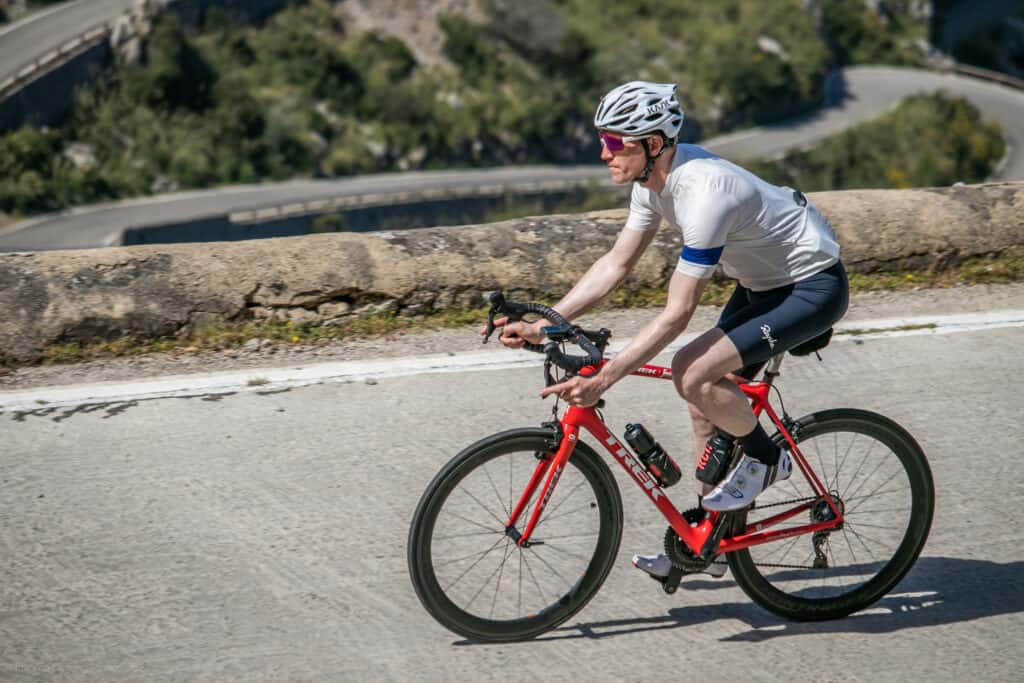
How to Train for Long Distance Cycling?
Let’s take a look at the best ways you can prepare yourself for those long, long (and longer…) rides.
Building Endurance
The most important part of training for long-distance rides is building up your cycling endurance. This means gradually improving your base fitness over a period of time.
We all have busy lives, and you probably won’t be able to train for six hours a day like a pro. So, you need to work out a training regime to fit into your schedule.
Honestly, the best way I’ve found to be consistent in training is to add training slots into your daily calendar and stick to doing them as best you can.
The best endurance training for long-distance riding is a combination of polarized training, interval training, and slower-paced long training rides. But what exactly are those training types?
This could be on a stationary bike or out on the roads. Keep your training sessions short to start with, and slowly increase their length as your endurance builds.
Polarized Training
Polarized training predominantly includes two contrasting zones of intensity: low-intensity training and high-intensity training, with minimal time spent in the moderate-intensity zone.
You may typically see this type of training defined as 80:20, and this approach is divided as follows:
- A significant proportion, typically around 70-80%, is spent in low-intensity training. This is often referred to as Zone 1. This zone helps to build endurance and promotes recovery.
- A smaller proportion, around 15-20%, is allocated for high-intensity training or Zone 3. These are hard workouts designed to increase power and speed.
- Minimal time, approximately 5-10%, is spent in the moderate-intensity zone or Zone 2.
The rationale behind polarized training is that it allows cyclists to avoid overtraining and burnout from too many moderate-intensity sessions. It also helps the body make clear adaptations to the stress of high-intensity and low-intensity workouts, leading to more substantial improvements in performance over time.
But! Be careful here. The zones Polarized Training zones 1-3 referenced are not the same as the traditional training zones model. Instead, the 3 zones of polarized training reference the relationship between lactate levels and power output – Lactate Threshold (LT) zones 1, 2, and 3.
Measuring lactate Threshold typically requires some kind of lab test, and so if that isn’t an option, then a way to approximate this is:
- LT1 (Lactate Threshold 1) is around mid-zone 3 in the seven-zone model
- LT2 is in the top half of Zone 4
- LT3 is zone 5 and above
So, to wrap this up and match up the polarised training to your standard training zone model, just go for something like this:
- 70-80% of your training sessions occur in Zones 1, 2, and lower Zone 3
- 5-10% in high zone 3 and zone 4
- 15-20% in zone 5 and above
Phew!
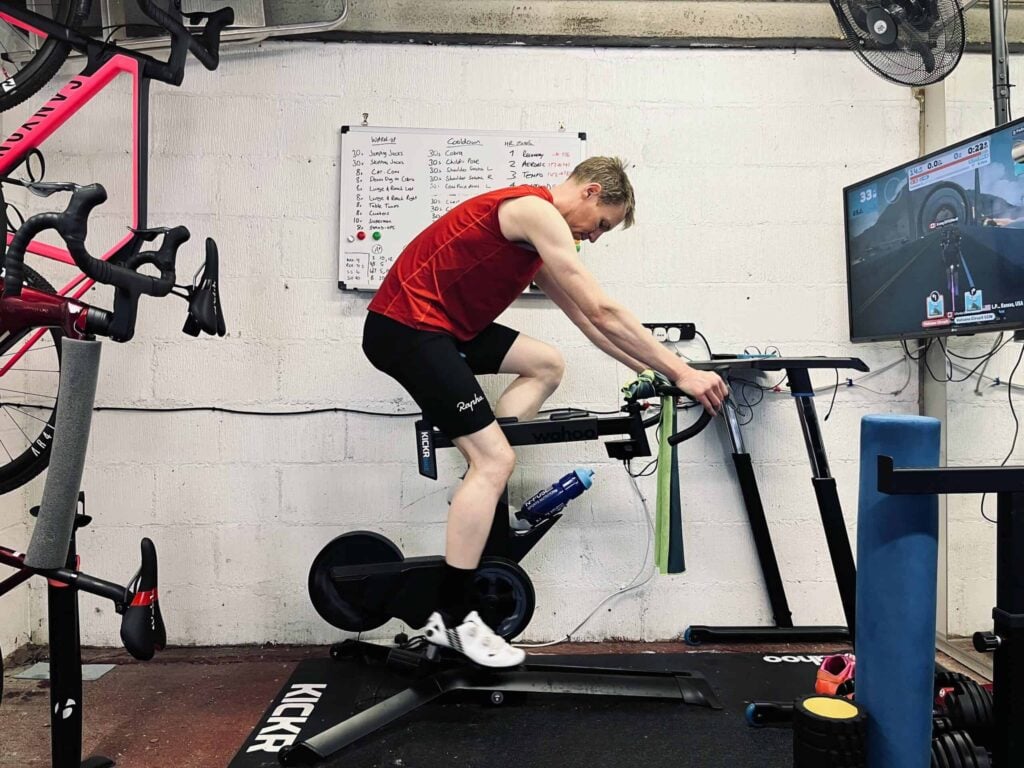
Interval Training
Interval training involves bursts of high-intensity activity interspersed with lower-intensity recovery periods. This type of training is designed to improve speed, power, and cardiovascular fitness.
Here’s a general structure of interval training:
- Warm-up period: A low-intensity cycling phase that prepares the body for the workout ahead.
- High-intensity interval: A period where you cycle at an intense pace, pushing your heart rate up to around 80-90% of its maximum.
- Recovery interval: A period of low-intensity cycling to allow your heart rate to decrease and your body to recover.
- Repeat: The high-intensity and recovery intervals are then repeated several times.
The duration and intensity of the intervals can vary based on the specific goals of the workout and the individual’s fitness level.
As an example, a session could include four 8-minute sets of high-intensity activity and four sets of 4-minute low-intensity periods.
Interval training has numerous benefits. It can improve both aerobic and anaerobic fitness, increase speed and endurance, and burn more calories in less time compared to steady-state workouts.
The key to building endurance is starting slowly and finding a regime that you can handle.
Strength Training for Cycling
Strength training is also important when you’re prepping for a long ride and will improve your power and endurance on the bike.
This cross-training also helps to delay fatigue, enhance maximal speed, and improve your anaerobic capacity.
Here are some strength training exercises that you can try:
Dumbbell split squat
- Start off with one of your feet in front of you, as you would perform a lunge. Your shoulders should be in line with your hips. Hold a dumbbell in each hand.
- Bend your knees to lower yourself by sinking your hips. Keep going until your back knee almost touches the floor and your knees are bent.
- Keep your back straight.
- Slowly straighten your legs and return to the starting position while exhaling.
- Maintain square shoulders and keep your chest lifted throughout the exercise.
- Perform 2-3 sets. Each set involves 8 to 12 reps on each side of your body, with 30 to 60 seconds of rest in between.
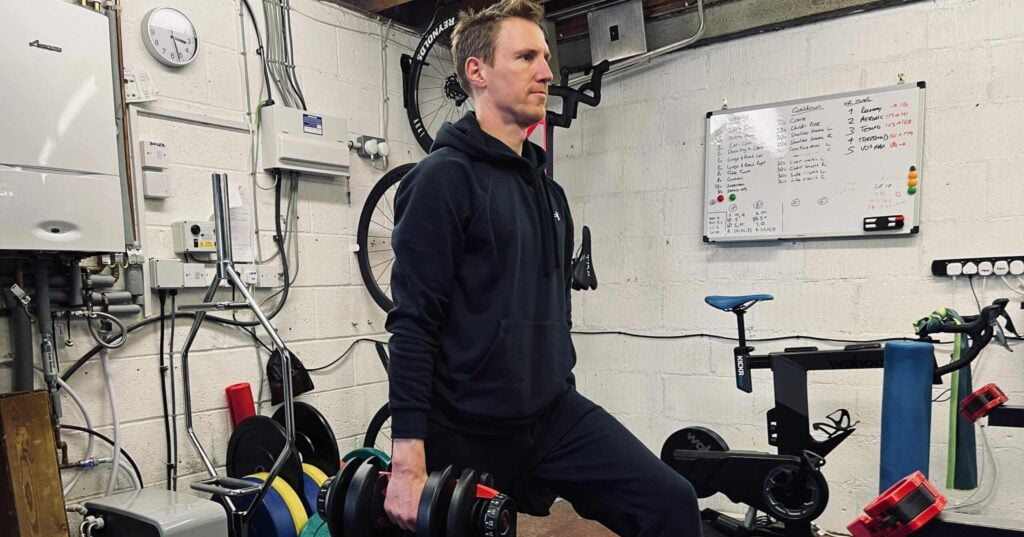
Glute bridge
- Lie on your back and place your feet hip-width apart, bending your knees and keeping your feet on the floor.
- Press your heels into the ground and push up your hips so that you’re resting on your shoulders. Your back, hips, and thighs should be straight. Think of a triangle – the three points are your knees, your feet, and where your shoulders and head rest on the floor.
- Then, slowly lower your hips back into the starting position.
- Perform 2-3 sets. Each set is 8 to 12 reps, with 30 seconds of rest in between.
- Tip: use a band around your thighs to make this a little more challenging. Something like the Fit Simplify Exercise Bands for added resistance during your workout. These bands come in different levels of resistance, allowing you to customize the intensity of your exercises. Incorporating resistance bands into your workout routine can help strengthen and tone muscles, improve stability, and enhance overall fitness.
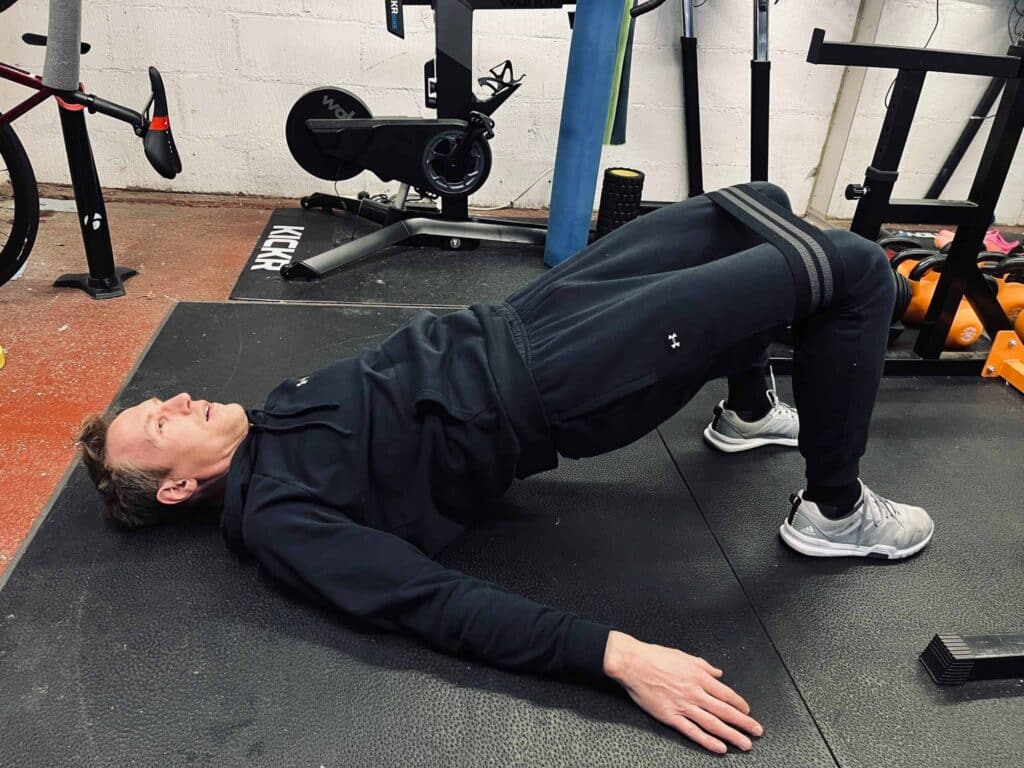
Push-up to side plank
- The first step is a normal push-up on your toes or knees.
- In the top push-up position, rotate your hips and lower body until you come to rest on the side of your feet. Your hips should be vertically stacked.
- Lift one of your hands off the ground and point it toward the sky. Your shoulders, hips, and feet should be aligned, and your raised hand should be in line with the hand on the ground. Hold this for 5 seconds, and then go back to the starting position.
- Repeat the process on the opposite side of your body.
- Do this 4 times for each side and then rest for 30 to 60 seconds. Repeat this process 2 to 3 times.
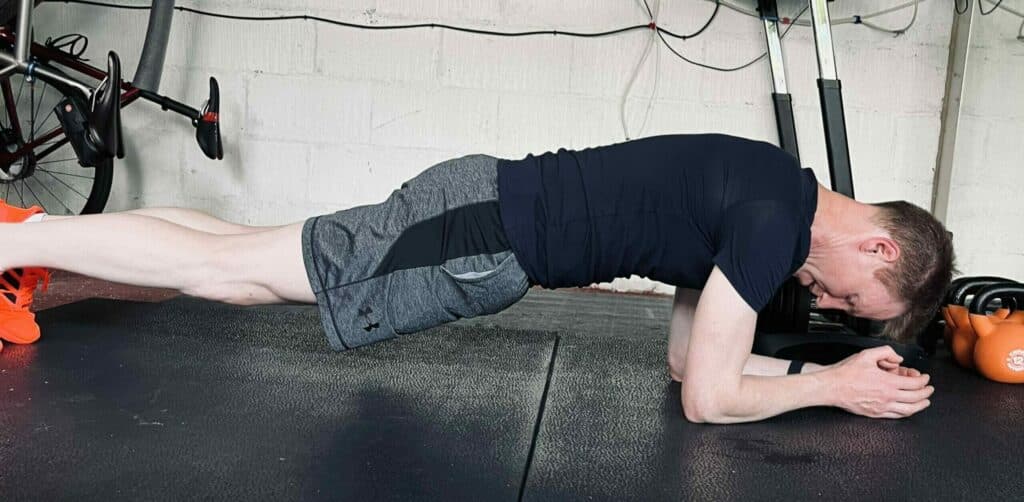
Proper Nutrition for Long Distance Cycling
You’ve probably heard the famous saying, “An army marches on its stomach.” Well, the same is true for any long-distance ride. You need to make sure that you’re properly fueled before, during, and after all your long rides.
But there is no one-size-fits-all approach to cycling nutrition. Still, there are some tips that apply to most long-distance cyclists.
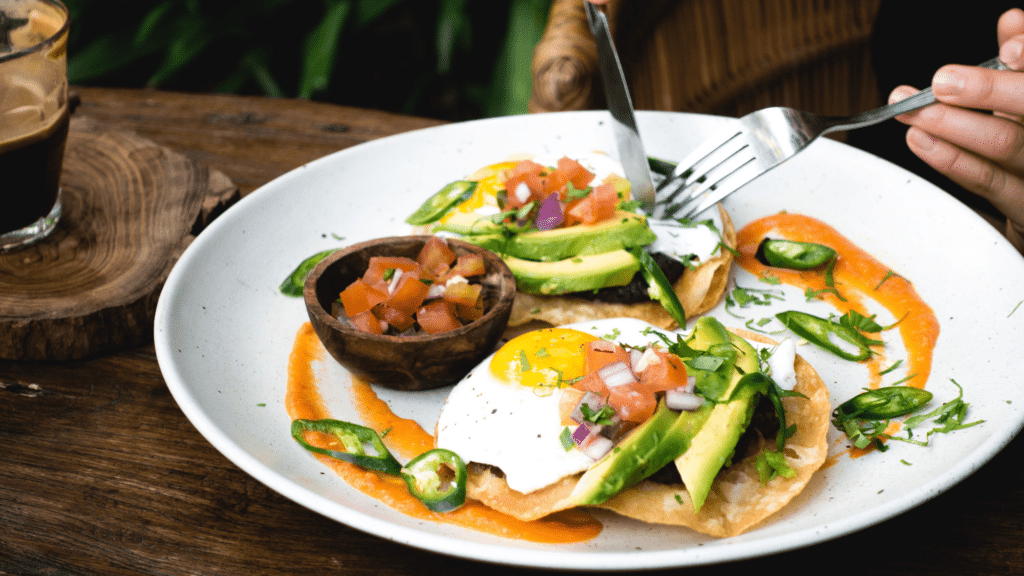
Pre-ride
On the morning of a long-distance ride, eat a meal that is rich in complex carbohydrates, moderate in protein, and low in fat and fiber to ensure easy digestion and avoid stomach discomfort.
You should aim to eat your meal around 2 hours before starting your ride. Here’s an example of a balanced pre-ride meal:
- A bowl of whole-grain cereal or oatmeal with low-fat milk or a dairy-free alternative.
- A side of a banana or other easily digestible fruit for an extra dose of carbohydrates.
- A boiled egg or a serving of Greek yogurt for a hit of protein.
If you’re pressed for time before your ride, I’d recommend a quick, light snack that’s easy on the stomach. A banana or a rice cake, perhaps even a low-fiber energy bar like a CLIF Bar, can give you that necessary energy boost.

Such snacks are great for a pre-ride nibble to ensure you’re powered up without feeling weighed down. Keeping these snacks handy has always helped me sustain my energy and stave off hunger throughout those long stretches in the saddle.
Remember to hydrate before your ride, too. As you are preparing for a long ride, you might consider an electrolyte drink.
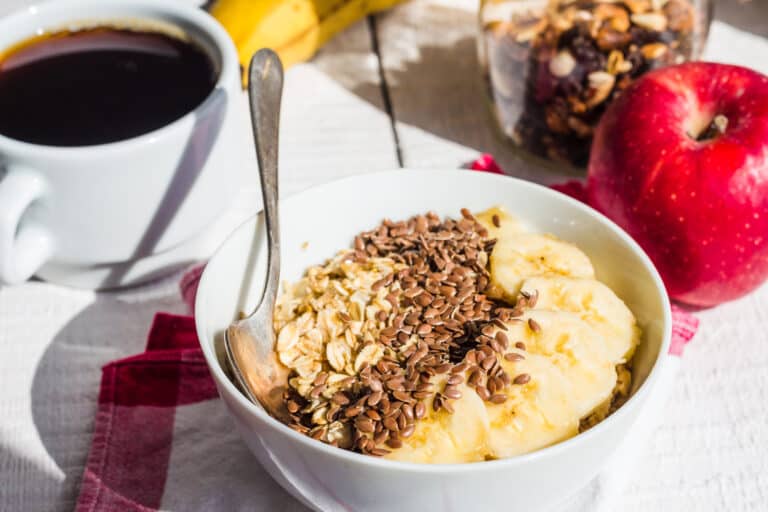
During the ride
Most cyclists need about 40 to 80 grams of carbs per hour during a long ride. To keep your muscles topped up and maintain energy, you should be eating every 20-30 minutes while riding.
Also, don’t forget to keep drinking and stay hydrated, ideally with an electrolyte tab. Something like Nuun works well to replenish electrolytes lost through sweat and maintain proper hydration levels.
These tabs provide essential electrolytes like sodium, potassium, and magnesium, helping you stay hydrated and perform at your best throughout your ride.
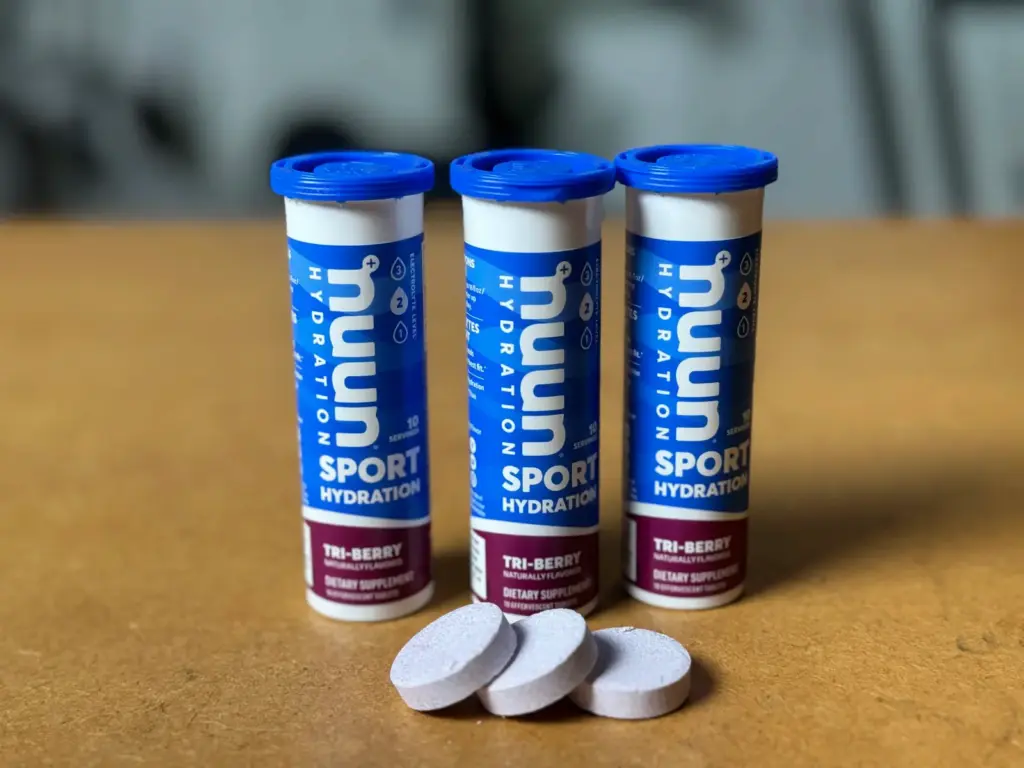
There are a few options for how to get your carbs during a ride, and a lot of it comes down to personal preference, what you can stomach (literally!), and how you take it onboard.
Personally, I will typically go with a mix of:
- Energy drink mix in my bottle (I will add this to the same bottle as an electrolyte tab – although be mindful of the flavor cocktail!).
- Energy bars, flapjack, etc.
- Energy chews.
- Natural foods like a banana.
- Energy gels. Which I normally carry but am not a big fan of, so would only use it if desperate and nearer to the end of the ride.
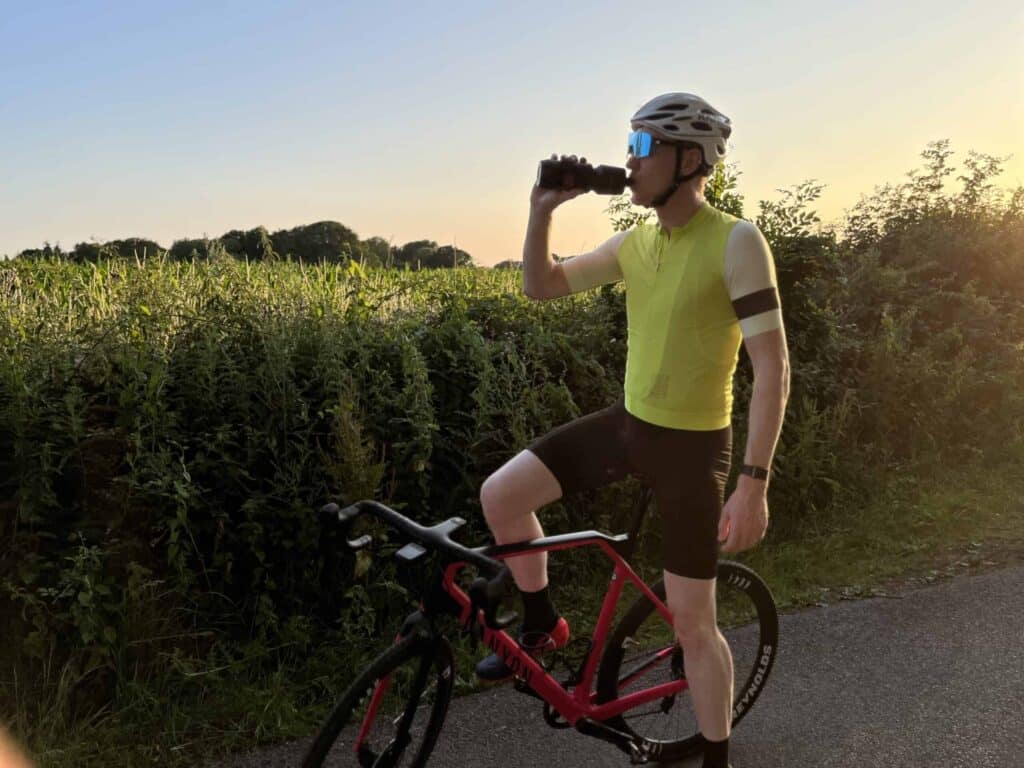
Post-Ride
Nutrition plays an integral role in your recovery process after a long bike ride. It’s not just about refuelling; it’s about providing your body with the necessary nutrients to repair, rebuild, and strengthen itself for your next effort.
Firstly, replenishing your carbohydrate stores is essential. During a long ride, your body uses up its glycogen stores. Consuming carbs after the ride helps to refill these stores, providing your body with the energy it needs to function properly and recover. Foods such as pasta, rice, and wholegrain bread are good options for this purpose.
After a long ride, it’s crucial to refuel with both protein and carbs to kickstart your recovery. Protein is especially important for repairing and rebuilding your muscles.
For a quick and effective post-ride fix, I recommend mixing up a shake with Ascent Whey Protein Powder within 30 minutes of finishing your ride.
Not only does it provide high-quality protein, but it also contains leucine, which is essential for muscle synthesis. If you prefer whole foods, you can opt for lean meats, eggs, or plant-based choices like lentils and tofu.
But for convenience and efficiency, the Ascent protein shake is an easy win for post-ride nutrition.
Hydration is also vital. Don’t forget to replenish your fluids and electrolytes lost during the ride by consuming plenty of water or a sports drink designed for recovery.
Lastly, remember to include some healthy fats in your recovery meal. Foods like avocados, nuts, and seeds can provide the necessary nutrients to reduce inflammation and support overall recovery.
Trust me; taking care of your post-ride nutrition will make all the difference when you get back on the bike!

Rest and Recovery
Recovery is not only an essential part of endurance training for cyclists, but it’s also a crucial component of overall athletic performance.
While we often focus on physical exertion during training, it’s during the periods of rest and recovery that your muscles actually have the chance to repair themselves and grow stronger.
This process is what eventually leads to improvements in your cycling performance, making those challenging training sessions progressively easier (maybe not easier. Instead, you will keep on improving and go harder!).
Let’s explore some effective steps to optimize your recovery:
- Active Recovery involves light, low-intensity exercises, such as a slow bike ride or a walk. Active recovery can help to gently stimulate blood flow and promote muscle healing without adding stress to your body.
- Sleep: Quality sleep is one of the most effective ways to accelerate recovery. It’s during sleep that your body does much of its repair work on muscle tissues. Aim for at least 8 to 10 hours of sleep per night.
- Hydration and Nutrition: We’ve touched on the importance of post-ride nutrition earlier. Hydrating properly and eating a well-balanced diet rich in proteins, carbohydrates, and healthy fats support muscle recovery and replenish energy stores.
- Stretching and Mobility Exercises: Stretching after a ride can help to reduce muscle tension and increase flexibility, both important for recovery and injury prevention. Yoga or Pilates can be beneficial for maintaining overall body mobility.
- Massage or Foam Rolling: These can help to reduce muscle soreness and speed up recovery by improving blood circulation to the muscles.
- Rest Days: Don’t underestimate the power of a complete rest day. It can give your body the time it needs to fully recover and prevent overtraining.
Remember, recovery is as individual as training, so it’s important to listen to your body and give it the rest it needs when it needs it.
Give yourself time to cool down
I know the feeling – we all know the feeling! You’ve just finished an intense training session, and all you want to do is get off the bike and rest.
Although it may seem counterintuitive, this isn’t actually good for recovery.
Before you hop off the bike, you should have a cool-down period of at least 10 minutes. A “cool-down” is a period of very low-intensity cycling to help your body return to its “pre-exercise” state.
Get your legs elevated
The practice of elevating your legs after strenuous physical activity, such as a long bike ride, is recommended and can be beneficial.
Your legs indeed bear a significant burden during an intense cycling session, and elevating them can help alleviate some of the impacts.
Lying down with your legs up against a wall can encourage venous blood flow back to the heart, helping to reduce pooling and potentially decrease swelling. The gentle stretch to your hamstrings can also aid in muscle recovery.
If you’re feeling light-headed, this position could help restore blood flow to your brain.
Get some quality sleep
I know it’s not always easy to stick to a regular sleeping schedule, but it’s one of the best things you can do to aid in your recovery.
Your body produces the human growth hormone (HGH) during deep sleep, which stimulates muscle repair and growth. If you’re not getting enough deep sleep, your body doesn’t have the chance to recover and rebuild muscles.
You should aim to get 8 to 10 hours of sleep a night while you’re training. This gives your body the best possible chance of repairing itself for that next long ride.
Mental Preparation for Long-Distance Cycling
I’ve already discussed how you can train yourself physically, but you also need to train your mind to be able to cope with the physical stress of endurance rides.
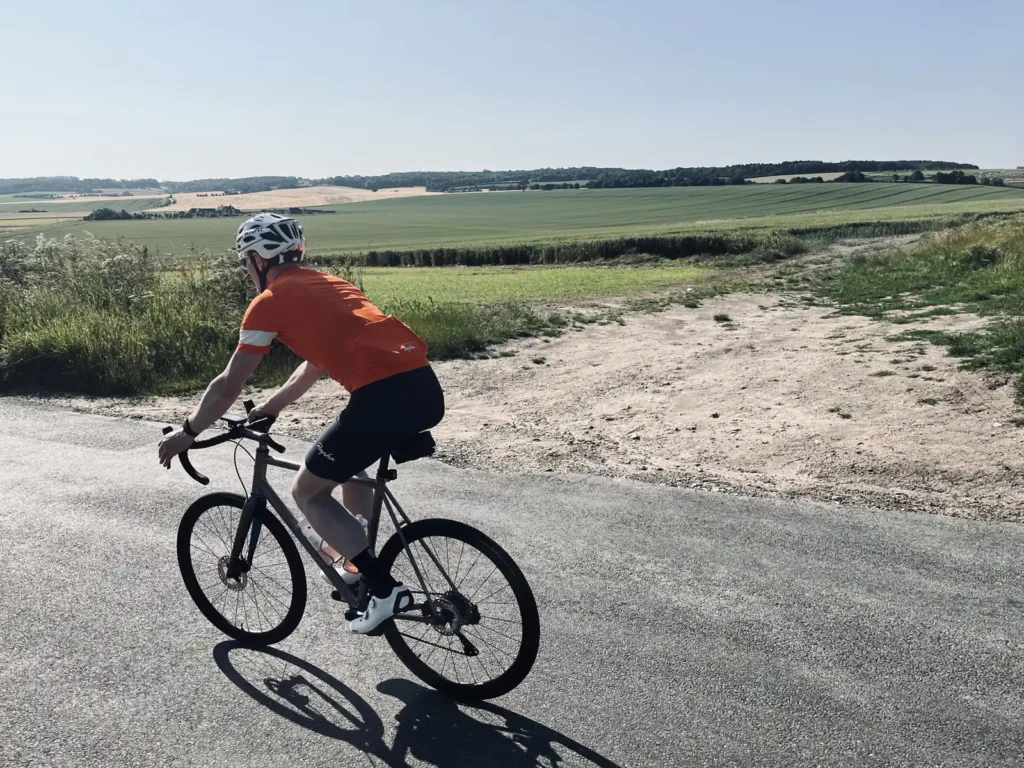
Here are some tips you can use to get you through the toughest stretches.
Success visualization
Build a mental script for your perfect training session. Visualize how you’ll start, how you’ll pace yourself, and how you’ll react if something goes wrong.
Play this out in your mind so that it becomes automatic when you need to put it into practice.
Train yourself to calm your nerves
It’s natural to get a little nervous before a long ride. To deal with your nerves, create a pre-ride routine. This could involve tasks like lubing your chain, pumping your tires, and filling your water bottle.
Focusing on these chores will distract you from those butterflies. Speaking of chain lube, I recently discovered this stuff, and loving the performance with the convenience, but sshhh – it’s a secret!
In the flurry of anticipation before a significant cycling event, it’s easy to get swept up in nervous energy. This is where you could also introduce a moment of stillness and focus on your breathing.
Try to slow your breathing down, taking deeper and longer breaths. The act of concentrating on your breath helps to slow down your heart rate and calm the nervous system.
A simple method is the “4-7-8” technique: inhale for a count of 4, hold the breath for a count of 7, and exhale for a count of 8.
Mindful breathing not only calms you down but also helps to improve oxygen delivery to your muscles, preparing your body for the physical exertion to come.
Come up with some mantras
In your downtime, think of a few motivational phrases you can use when the going gets tough. They only need to be simple. Phrases like “You’ve got this” or even “The hill is flat” before a steep hill can give you the boost you need to keep going.
My favorite: “This is Exciting! (repeat, over and over). But. maybe you can’t go wrong with the FNL epic “Clear Eyes, Full Heart, Can’t Lose“.
Next Steps: Consult with a Professional Coach or Trainer
It’s difficult to formulate your own schedule and identify areas where you need improvement, especially if you’re a beginner.
To find your ideal training regime, you should consult with a professional coach or trainer. They can analyze your performance and help you design a tailored training program to maximize your potential.
FAQs
Should I use a power meter during long-distance cycling training?
Using a power meter on long rides allows you to track your power output and plan your training sessions more effectively. I’d recommend using one.
How do I tell if I’m overtraining?
The most common signs of overtraining in cyclists are changes to your usual sleep pattern, decreased sleep quality, and an increase in colds or other illnesses. Also, you may notice a lack of energy when performing training rides.
Why is your aerobic capacity important for long-distance cycling?
Aerobic capacity is so important because cycling is mostly an aerobic activity that puts strain on your lungs, heart, and blood vessels. This is why aerobic training is vital for those looking to tackle longer rides.
Is a 30-minute bike ride too long?
Probably not 😉 The duration of a bike ride, such as a 30-minute session, largely depends on an individual’s fitness level, the intensity of the ride, and personal comfort. High-intensity rides might be shorter whilst lower-intensity rides could be longer.
Ultimately, it’s essential to listen to your body and adjust your workout accordingly, ensuring it’s enjoyable and beneficial for you.
